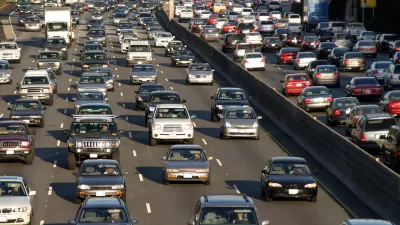What does a successfully multi-modal and livable street look like? There are examples all over the world, if you're paying attention.

Jeff Speck writes for CityLab about the next front in the ongoing contest to control the design of streets. On one side are cars and traffic engineers, but the latter of those two have ceded ground in recent years to pedestrians and placemaking.
Noting recent successes, Speck asks the questions: "What is the next urgent battle to be fought in the name of more walkable, livable streets and communities?" And, "what if there were one category that managed to include all the others?"
Speck answers these inquiries affirmatively, noting the importance of models, otherwise known as paying attention to precedent. Speck even has a case study with which to make his point, with the example of Lowell, Massachusetts' plan to transform a below-grade highway, with an elevated traffic circle, into a boulevard. Grant Welker reported on the details of the proposed redesign for the Lowell Sun. Speck critiques the current plan by appealing to precedents.
While there exist a growing number of locations in America with street configurations like this one, it is impossible to name one with street life. Swoopy configurations like this design are found mostly in suburban drive-only locations out by the mall, not in cities. If no attractive place can be found with a similar configuration, then a design should not pass the street-planning smell test.
To counter the current proposal, Speck chooses his own precedent—as set by The Boulevard Book by Alan Jacobs, which laid out the fundamental ingredients for a boulevard that both moves cars and provides a walkable urban setting.
FULL STORY: The Simplest Way to Avoid Bad Street Design: Copy the Ones That Work

Maui's Vacation Rental Debate Turns Ugly
Verbal attacks, misinformation campaigns and fistfights plague a high-stakes debate to convert thousands of vacation rentals into long-term housing.

Planetizen Federal Action Tracker
A weekly monitor of how Trump’s orders and actions are impacting planners and planning in America.

In Urban Planning, AI Prompting Could be the New Design Thinking
Creativity has long been key to great urban design. What if we see AI as our new creative partner?

King County Supportive Housing Program Offers Hope for Unhoused Residents
The county is taking a ‘Housing First’ approach that prioritizes getting people into housing, then offering wraparound supportive services.

Researchers Use AI to Get Clearer Picture of US Housing
Analysts are using artificial intelligence to supercharge their research by allowing them to comb through data faster. Though these AI tools can be error prone, they save time and housing researchers are optimistic about the future.

Making Shared Micromobility More Inclusive
Cities and shared mobility system operators can do more to include people with disabilities in planning and operations, per a new report.
Urban Design for Planners 1: Software Tools
This six-course series explores essential urban design concepts using open source software and equips planners with the tools they need to participate fully in the urban design process.
Planning for Universal Design
Learn the tools for implementing Universal Design in planning regulations.
planning NEXT
Appalachian Highlands Housing Partners
Mpact (founded as Rail~Volution)
City of Camden Redevelopment Agency
City of Astoria
City of Portland
City of Laramie




























